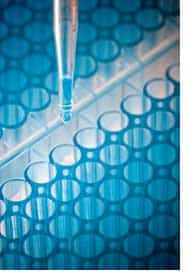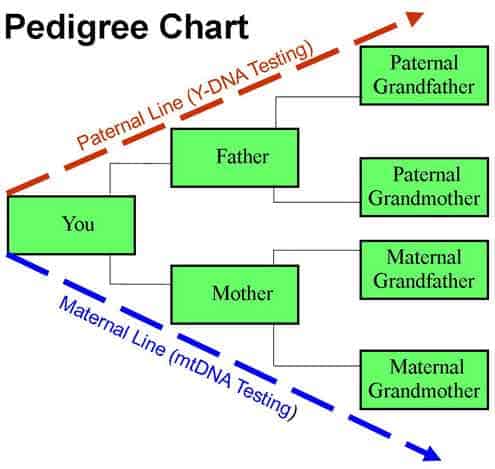
DNA genealogy applies the science of DNA to the practice of genealogy.
As a result, nearly all the web sites that discuss the subject are heavy on science and technical jargon.
The science is interesting and I will cover it elsewhere. But maybe you just want to know what DNA testing can do for you.
This page provides that simplified introduction without the science lesson.
First, I want to clear up four common misconceptions.
Misconception #1: DNA Is Automated Genealogy
Some people think they just submit a DNA sample and get back their entire family tree. That’s not how it works. DNA can do many wonderful things. But you still have to combine your DNA findings with conventional genealogy to build your family tree.
Misconception #2: Only Men Can Submit DNA for Testing
Yes, only men have a Y-chromosome. So the Y-DNA test is only for men. But there’s an mtDNA test that’s open to both men and women. Furthermore, many women participate in Y-DNA testing by proxy. You simply get an appropriate male relative to submit his DNA for testing. I’ll explain “appropriate” a little later on this page.
A recent breakthrough in genetic genealogy is autosomal DNA testing which can be done by men or women.
Misconception #3: DNA Testing Risks Your Privacy
The Y-DNA test and the most widely used mtDNA genetic genealogy tests only examine portions of your DNA that have nothing to do with physical traits or genetic disorders. Those results are meaningless from a medical viewpoint.
In addition, genealogists designed these DNA genealogy tests to look for common ancestors rather than identify individuals. So these particular tests are not suitable for criminal investigations.
Misconception #4: DNA Testing Requires a Blood Sample
At one time that was the case. But it’s now possible to analyze DNA from other samples that you can easily collect yourself. Most DNA testing labs provide you with a buccal swab that you rub inside your cheek or a tube for collecting saliva. Either way it’s simple and painless. You collect the sample at home and mail it back to the lab for analysis.
Testing Your Family Tree with DNA Genealogy
What DNA does do is confirm that certain people have common ancestors. To see what I mean, look at the following Pedigree Chart. It’s a simplified diagram of your family tree. It begins with you on the left and goes back in time through your parents and grandparents.

The Paternal Line.
Your paternal line runs along the top of the chart through your father, his father, etc. If you’re a male, your Y-chromosome passed down along this path. Y-DNA testing can help you identify or confirm the men in your paternal line. Since surnames usually don’t change along this line, Y-DNA test results are particularly easy to work with.
Females can participate in Y-DNA testing by sampling any living male in your paternal line. This could be your brother, your father, your father’s brother, or a son of your father’s brother etc.
The Maternal Line
Your maternal line runs along the bottom of the chart through your mother, her mother, etc. The test that connects people in the maternal line is mtDNA testing. Since a mother passes on her mtDNA to ALL her children, both males and females can take this test.
In Western cultures, a female’s surname typically changes every generation. That means the connections suggested by mtDNA testing may be less obvious than the results of Y-DNA testing. That’s why I recommend, when possible, that you try Y-DNA testing first.
Exploring the Center of Your Chart
Notice that a Y-DNA test or an mtDNA test of your own DNA will not tell you anything about your paternal grandmother or your maternal grandfather. As you go farther back in time, this unexplored center of the chart gets bigger and bigger.
Fortunately, if you have a genealogical mystery you want to solve in the center of your chart, you can still use those tests. You just have to get creative about finding the right subjects.
For example, any son of your maternal grandfather, any son of that grandfather’s brothers, or any son of those sons would share the same Y-chromosome. So a Y-DNA test on any one of them will cover your maternal grandfather and the male line before him.
Likewise, you can cover your paternal grandmother and the female line before her through an mtDNA test of your father, any of his siblings, any of that grandmother’s siblings or any child of her daughters or sisters.l
Autosomal DNA Testing
Now you can also use autosomal DNA testing to find or confirm relationships from anywhere in your family tree back to about five generations.
Three companies offer this test: Family Tree DNA offers the Family Finder test. The 23andMe test and the AncestryDNA test are worthwhile alternatives to Family Finder. Each test has its own strengths and many adoptees and serious genealogists are using all three now that the price of each test has dropped below $100.
Comparisons Needed
DNA test results for any one person will include many numerical values. But those numbers won’t mean much by themselves. Meaningful information in DNA genealogy comes from comparisons. If two people have a strong match, they’re sure to have a common ancestor.
Sometimes two people will submit samples at the same time because they have a potential common ancestor in mind.
But most people simply submit their own DNA and compare themselves with the growing databases of people already tested PLUS those people who will be tested in the future. That’s potentially the most exciting aspect of DNA genealogy, because you can find people in parallel branches of your ancestral tree.
A Worthwhile Investment
The money you spend on DNA genealogy testing can save you a lot of time and effort in building your family tree. For example, you can focus on families that definitely relate to you instead of looking at everyone with your surname.
Sometimes DNA genealogy will disprove an assumed relationship. If that happens in your tree, you can quit wasting time on a false line with no biological connection to you. Instead, you can use your DNA connections to help uncover the true line.
Finally, Y-DNA, mtDNA, and autosomal DNA tests can all introduce you to genetic cousins who descend from common ancestors. Besides the friendships that may develop, these cousins could have information on your family that you haven’t found yet. This alone can save you a tremendous amount of research.
What Next?
Future pages in the Family Trees section will explain the science of Genetic Genealogy that makes this possible. I’ll also show you where and how to get tested. Finally, I will cover how to interpret the results and other steps you can take from there.
DNA genealogy can also tell you about ancestors that lived thousands of years ago. See my section on Ancient Ancestry. In this Family Trees section of my site I focus on test results that can tie you to specific individuals in your family tree.
